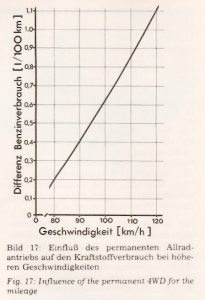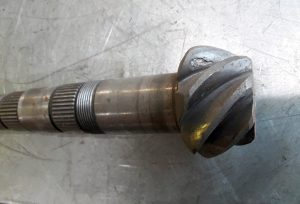First of all: It’s not our intention to make the decoupler look bad – we also fitted one, and think it’s a nice gadget – but we prefer to drive most of the time in 4WD-mode. You may ask why?
There are at least 2 good reasons – which are somehow connected:
-
Better mileage with Viscous Coupling engaged than disengaged
It’s no typing error. Especially at higher speeds, the Syncro consumes more fuel when decoupled. The widespread assumption that a decoupler gets you better mileage is wrong – in fact the opposite is true.
This is not just a statement of ours, it’s based on reliable data from the Austrian manufacturer Steyr-Daimler-Puch (SDP). In 1985, the new development of the VW T3 Syncro has been presented in detail in the “ATZ – Automotive Technical Journal”.
At that time, SDP had tested the novelty Visco transmission parallel with the old fashioned decoupler. They found out, that the viscous coupling saved 3% fuel in comparison with a decoupled Syncro. In chapter “performance” you will find the following explanation on page 415:
“Im Rahmen der Entwicklung wurde auch die Abschaltung des Vorderachsantriebs untersucht. Bild 17 zeigt die Differenz der Konstantverbrauchskurve des VW Syncro mit Bereifung 205 R 14 und Achsantriebsübersetzung 38:7 als vierrad- gegenüber dem zweiradgetriebenen Fahrzeug. Besonders bei höheren Geschwindigkeiten zeigt sich deutlich der Vorteil des permanenten Allradantriebs. Die Ursache liegt hauptsächlich im günstigeren Rollwiderstand und geringerem Schlupfverlust der zum Vortrieb angetriebenen vier Reifen statt der sonst üblichen Leistungsübertragung durch zwei Reifen. Im praktischen Kundeneinsatz […] wurde mit Allradantrieb über Visco-Kupplung gegenüber einem vergleichsweise mitlaufenden VW Syncro mit nur Heckantrieb eine Verbrauchsreduzierung von 3% gemessen.“
For everyone in short who doesn’t understand German:
Especially at higher speeds, the advantage of permanent four-wheel drive is clearly visible. The cause mainly lies in the more favorable rolling resistance and lower slip loss, due to four driven tires instead of two. In practical customer use […] a reduction in fuel consumption of 3% was measured with all-wheel drive via Viscous coupling compared with a comparatively decoupled driven VW Syncro with rear-wheel drive only.
The full ATZ article can be found here:
https://shufti.files.wordpress.com/2010/05/atz_87_1985.pdf
As one can see from the consumption curve in Figure 17, the influence increases with the speed.
At 100km/h the consumption increases about 0.6 liter, while the effect is already 1.1 liter at 120km/h. The consumption figures are based on the 1,9L DG 78hp engine. With the later 2.1L water boxer, the consumption deviations tend to be higher.
In addition, the former moderator (Les Harris) of the now closed Yahoo Group named “Syncro_T3_Australia” – who passed away in 2017 – ran a controlled test over 30.000 km to find out how much fuel a decoupler saves. Here is a quote from the original: (page is already offline)
“I ran a controlled test on a standard MV engine over 30,000 km (18,640 miles) in 2WD (decoupled) and in 4WD (coupled) over identical running conditions and for which I have kept full notes.
The result was that 4WD produced 0.8 km/litre (1.88 MPG) BETTER consumption than decoupled 2WD.”
Almost two mpg better mileage. I’m not sure why the Syncro AWD is assumed to get worse fuel economy than 2WD, perhaps because that’s been the norm for domestic 4WD trucks.
Larry H.”
Les Harris confirmed therefore unintentionally the data from SDP of 1985 in the ATZ.
-
Higher wear of the Syncro transmission decoupled
Many Syncros drive on the motorway decoupled to save their viscous coupling. We ran a test over 10.000km with intentionally uneven worn tires, and we could not find any signs of aging regarding our Co2-VC.
But what’s for sure is the higher stress load on the gear box when driving decoupled on the motorway. The fight against air resistance of the VW T3 body needs high power load. In decoupled mode the rear crown and pinion sets (which are the weakest link) take all the load and wear much faster.
A working VC will always relieve the gear box from a certain amount of load – the faster your go, the bigger the amount gets.
The gearbox damages to rear crown and pinion (especially in high-performance TDI engines) are an undoubtable reality. By contrast, the number of Kern-VCs that are being crushed by motorway driving is zero. You decide.



